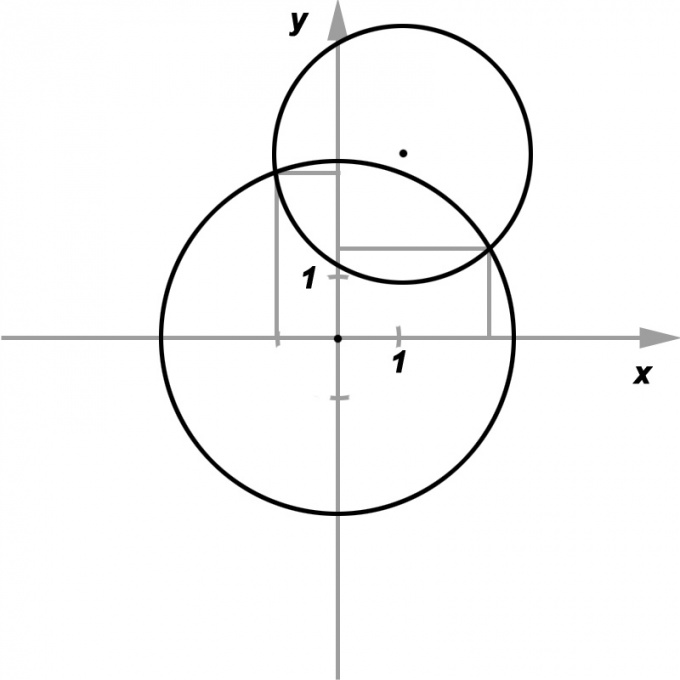Instruction
1
Suppose that the two circles are specified by their radii R and R, and the coordinates of their centers are respectively (x1, y1) and (x2, y2). Want to calculate the intersect these circles, and if so, find the coordinates of the points of intersection.For simplicity, we can assume that the center of one of the specified circles coincides with the beginning of coordinates. Then (x1, y1) = (0, 0) and (x2, y2) = (a, b). It also makes sense to assume that a ≠ 0 and b ≠ 0.
2
Thus, the coordinates of the point (or points) of intersection of the circles, if they exist, must satisfy the system of two equations:x^2 + y^2 = R^2,
(x - a)^2 + (y - b)^2 = r^2.
(x - a)^2 + (y - b)^2 = r^2.
3
After opening parentheses of the equation be:x^2 + y^2 = R^2,
x^2 + y^2 - 2ax - 2by + a^2 + b^2 = r^2.
x^2 + y^2 - 2ax - 2by + a^2 + b^2 = r^2.
4
Now the first equation can be subtracted from the second. Thus, the squares of the variables disappear, and there is a linear equation: -2ax - 2by = r^2 - R^2 - a^2 - b^2. It can be used to Express y in x:y = (r^2 - R^2 - a^2 - b^2 - 2ax)/2b.
5
If we substitute the obtained expression for y in the circle equation, the problem reduces to the solution of the quadratic equation: x^2 + px + q = 0, kder = -2a/2b,
q = (r^2 - R^2 - a^2 - b^2)/2b - R^2.
q = (r^2 - R^2 - a^2 - b^2)/2b - R^2.
6
The roots of this equation allows to find the coordinates of the points of intersection of the circles. If the equation is unsolvable in the real numbers, the circles do not intersect. If the roots coincide, then the circles touch each other. If the roots are different, then the circles intersect.
7
If a = 0 or b = 0 then the initial equations are simplified. For example, when b = 0 the system of equations becomes:x^2 + y2 = R^2,
(x - a)^2 + y^2 = r^2.
(x - a)^2 + y^2 = r^2.
8
After subtracting the first equation from the second, it turns out:- 2ax + a^2 = r^2 - R^2.Its solution is: x = - (r^2 - R^2 - a2)/2a. It is obvious that in the case b = 0 the centres of both circles lie on the x-axis, and their points of intersection will have the same abscissa.
9
This expression for x can be substituted in the first equation of a circle to obtain a quadratic equation relative to y. Its roots are the ordinates of the points of intersection, if any exist. In the same way have an expression for y, if a = 0.
10
If a = 0 and b = 0, but R ≠ r, then one of the circles is obviously inside the other, and points of intersection do not exist. If R = R, of the circle coincide, and the points of intersection are infinitely many.
11
If none of the two circles centre does not coincide with the origin, their equations will have the form:(x - x1)^2 + (y - y1)^2 = R^2,
(x - x2)^2 + (y - y2)^2 = r^2.If you go to the new coordinates resulting from the old method of parallel transport: x' = x + x1, y' = y + y1, these equations take the form:x'^2 + y'^2 = R^2,
(x' is (x1 + x2))^2 + (y' - (y1 + y2))^2 = r^2.The task thus reduces to the previous one. Finding the solution for x' and y', it's easy to go back to the original coordinates, making the equation for parallel transport.
(x - x2)^2 + (y - y2)^2 = r^2.If you go to the new coordinates resulting from the old method of parallel transport: x' = x + x1, y' = y + y1, these equations take the form:x'^2 + y'^2 = R^2,
(x' is (x1 + x2))^2 + (y' - (y1 + y2))^2 = r^2.The task thus reduces to the previous one. Finding the solution for x' and y', it's easy to go back to the original coordinates, making the equation for parallel transport.
